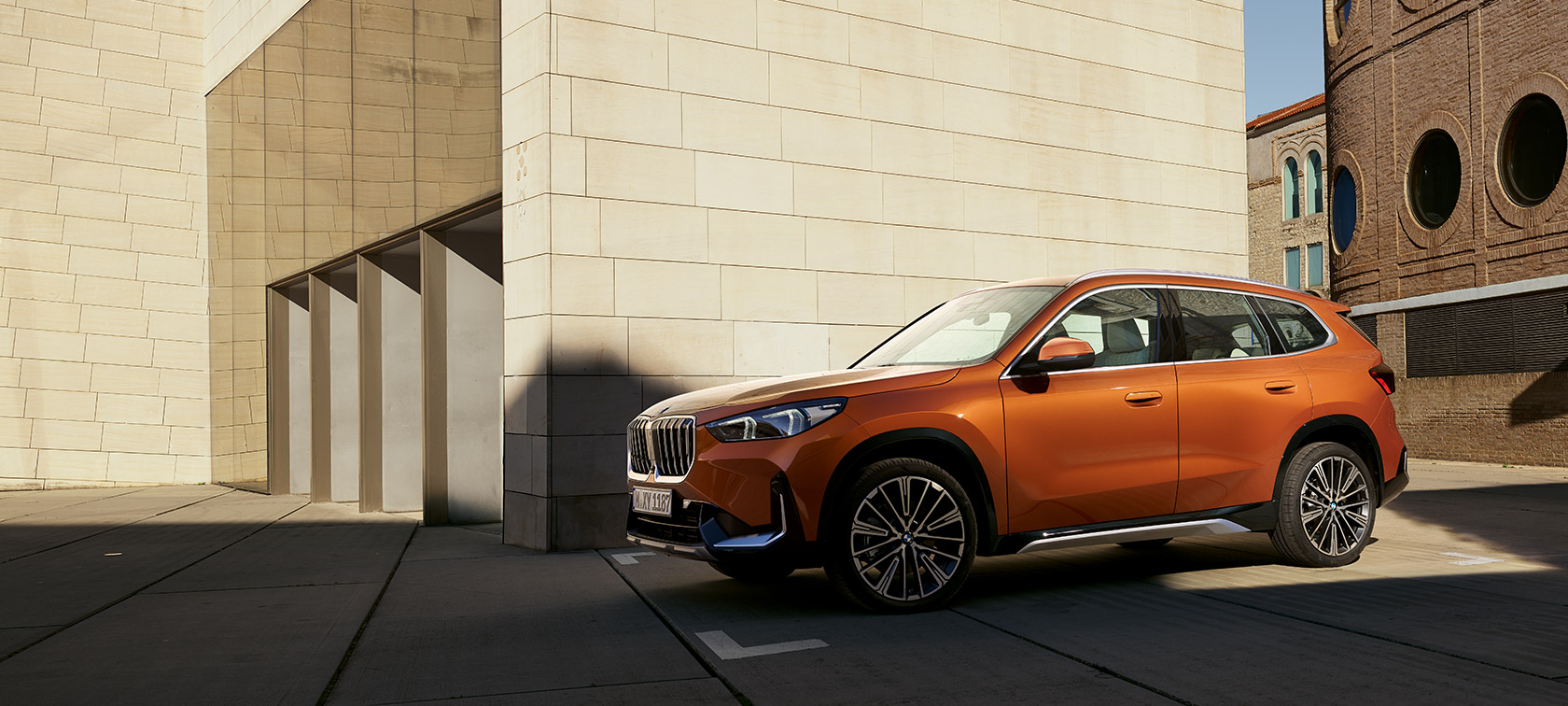Our tool for managing your permission to our use of cookies is temporarily offline. Therefore some functionality is missing.

THE X1
BMW X1: ENGINES & TECHNICAL DATA.
The key facts and figures for the BMW X1 at a glance:
- Engine, consumption and CO2 emissions
- Performance data such as displacement, hp, Nm and acceleration
- Weight, dimensions, wheel and tyre sizes
TECHNICAL DATA.
- BMW X1 sDrive20i
No search result found. Please try another input

| Luggage capacity min. (seats up) in l | 1600 |
|---|---|
| Luggage capacity max. (seats down) in l | 540 |
| Cylinders/valves | 4/4 |
|---|---|
| Capacity in ccm | 1998 |
| Stroke/bore in mm | 94.6/82.0 |
| Nominal power in kW (hp) at 1/min | 150 (204)/5,000 - 6,500 |
| Nominal torque (Nm) at 1/min | 300/1,450 - 4,500 |
| Compression ratio : 1 | 11.1 |
| Acceleration 0–100 km/h in s | 7.6 |
|---|---|
| Top speed in km/h | 236 |
| Fuel consumption, combined in l/100 km | 7.0 |
|---|---|
| CO2 emissions, combined in g/km | 158 |
| Tank capacity, approx. in l | 54 |
| Tyre dimensions front | 245/45R19 |
|---|---|
| Tyre dimensions rear | 245/45R19 |
| Wheel dimensions and material front | 8 J x 19 Light Alloy |
| Wheel dimensions and material rear | 8 J x 19 Light Alloy |
Fuel consumption and CO2 emissions.
BMW X1 sDrive20i:
Energy consumption, combined WLTP in kWh/100 km: 7.0
CO2 emissions, combined WLTP in g/km: 158
The figures for performance, consumption and CO2 emissions refer to vehicles with standard transmission.
[1] Performance data of petrol engines apply to vehicles using RON 98 fuel. Fuel consumption data apply to vehicles using reference fuels in accordance with EU Regulation 715/2007. Unleaded RON 91 and higher with a maximum ethanol content of 10% (E10) may also be used. BMW recommends RON 95 fuel. For high-performance automobiles, BMW recommends RON 98 fuel.
[2] For plug-in hybrid: Electric drive depending on battery charging level.
[3] For plug-in hybrid: At temperatures below freezing, the fully electric drive system is only available after a few kilometres of driving, once the battery has heated to operational temperature.
[4] Official data for fuel consumption, CO2 emissions, power consumption and electric range was determined in accordance with the prescribed measuring procedure and corresponds to European Regulation (EC) 715/2007 in the applicable version. For ranges, data determined as per WLTP takes into account any optional equipment (available on the German market in this case). For vehicles that have been newly type approved since 1 January 2021, only the official data according to WLTP exists. In addition, NEDC values are deleted from the certificates of conformity as of 1 January 2023 by EC regulation 2022/195.
For more information about NEDC and WLTP measuring procedures visit www.bmw.com/wltp
Further information about fuel consumption and official model-specific CO2 emissions of new passenger cars can be found in the "Guideline for fuel consumption, CO2 emissions and electric power consumption for new passenger cars", available free of charge at all points of sale, at the Deutsche Automobil Treuhand GmbH (DAT), Hellmuth-Hirth-Str. 1, 73760 Ostfildern-Scharnhausen, Germany, and under https://www.dat.de/co2/.
[5] For plug-in hybrid: Weighted, combined (EC AC Charge Weighted)
[6] Range depends on various factors, in particular: individual driving style, route characteristics, outside temperature, heating/air conditioning, pre-conditioning.
[7] The charging performance depends on the state of charge, ambient temperature, individual driving profile and use of auxiliary consumers. The ranges shown are based on the WLTP best case. The charging times apply to ambient temperatures of 23 degrees Celsius after a preceding drive and may differ depending on the usage behaviour.
[8] The EC unladen weight refers to a vehicle with standard equipment and does not include any optional extras. The unladen weight includes a 90% full tank and a driver weight of 75 kg. Optional equipment may affect the weight of the vehicle, the payload and the top speed if the selected equipment has an impact on the vehicle's aerodynamics.
[9] Composed of combustion engine drive (specified nominal value) and electric drive (up to specified nominal value). Electric drive depending on battery charging level.
[10] Composed of combustion engine drive (specified nominal value) and electric drive (up to specified nominal value).
[11] Provisional figures; any missing figures were unavailable at the time of publication.

